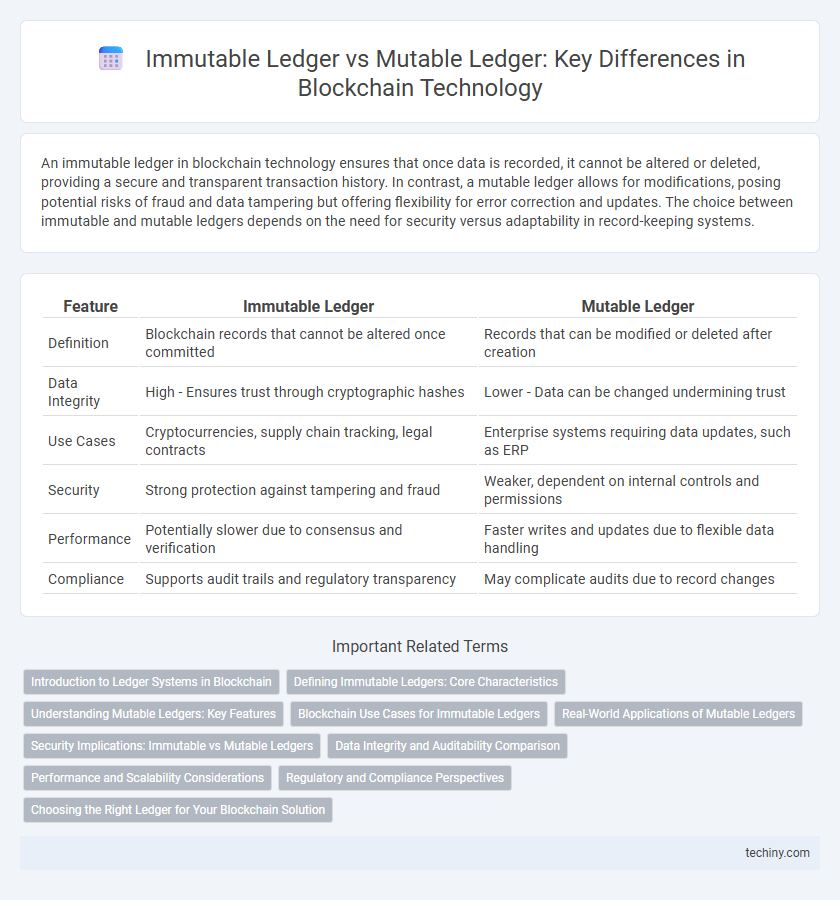An immutable ledger in blockchain technology ensures that once data is recorded, it cannot be altered or deleted, providing a secure and transparent transaction history. In contrast, a mutable ledger allows for modifications, posing potential risks of fraud and data tampering but offering flexibility for error correction and updates. The choice between immutable and mutable ledgers depends on the need for security versus adaptability in record-keeping systems.
Table of Comparison
| Feature | Immutable Ledger | Mutable Ledger |
|---|---|---|
| Definition | Blockchain records that cannot be altered once committed | Records that can be modified or deleted after creation |
| Data Integrity | High - Ensures trust through cryptographic hashes | Lower - Data can be changed undermining trust |
| Use Cases | Cryptocurrencies, supply chain tracking, legal contracts | Enterprise systems requiring data updates, such as ERP |
| Security | Strong protection against tampering and fraud | Weaker, dependent on internal controls and permissions |
| Performance | Potentially slower due to consensus and verification | Faster writes and updates due to flexible data handling |
| Compliance | Supports audit trails and regulatory transparency | May complicate audits due to record changes |
Introduction to Ledger Systems in Blockchain
Immutable ledgers in blockchain ensure data integrity by preventing any alteration or deletion of recorded transactions, providing a permanent and transparent history. Mutable ledgers allow changes or updates, which can introduce risks of data tampering but offer flexibility for correcting errors. Immutable ledger systems leverage cryptographic hashes and consensus mechanisms to maintain trustlessness and security, making them foundational to blockchain technology.
Defining Immutable Ledgers: Core Characteristics
Immutable ledgers in blockchain maintain a permanent, tamper-proof record of transactions that cannot be altered or deleted once confirmed. This core characteristic ensures data integrity, transparency, and trust across decentralized networks by preventing unauthorized modifications. By contrast, mutable ledgers allow changes to historical data, which can undermine security and accountability in distributed systems.
Understanding Mutable Ledgers: Key Features
Mutable ledgers allow data to be altered or deleted, offering flexibility and adaptability for dynamic environments such as enterprise databases and financial systems. Key features include controlled access permissions, version control mechanisms, and audit trails to maintain data integrity while enabling updates. This contrasts with immutable ledgers, which lock data permanently to ensure transparency and tamper resistance in blockchain applications.
Blockchain Use Cases for Immutable Ledgers
Immutable ledgers in blockchain provide a tamper-proof record of transactions, making them ideal for use cases such as financial services, supply chain management, and digital identity verification where data integrity is critical. Unlike mutable ledgers, which allow modification or deletion of records, immutable ledgers enhance security, transparency, and auditability by permanently storing transaction histories. Industries relying on compliance, anti-fraud measures, and trustless environments benefit significantly from blockchain's immutable ledger technology.
Real-World Applications of Mutable Ledgers
Mutable ledgers enable real-time updates and corrections, making them ideal for supply chain management where data accuracy and flexibility are crucial. In healthcare, mutable ledgers facilitate the dynamic updating of patient records while maintaining audit trails for compliance. Financial institutions leverage mutable ledgers to efficiently handle transaction reversals and error corrections without compromising data integrity.
Security Implications: Immutable vs Mutable Ledgers
Immutable ledgers, a core feature of blockchain technology, enhance security by preventing alteration or deletion of recorded data, ensuring transaction integrity and resistance to fraud. Mutable ledgers allow modifications, posing potential vulnerabilities such as unauthorized changes, data tampering, and reduced traceability, which can compromise system trustworthiness. The cryptographic principles underpinning immutable ledgers create a robust defense against cyberattacks, making them preferable for applications demanding high data security and transparency.
Data Integrity and Auditability Comparison
Immutable ledgers in blockchain ensure data integrity by preventing any alterations once a transaction is recorded, providing a permanent and tamper-proof audit trail. Mutable ledgers allow data modifications, which can compromise auditability and increase the risk of fraud or errors. The inherent immutability of blockchain ledgers supports robust compliance and transparent record-keeping critical for accurate audits.
Performance and Scalability Considerations
Immutable ledgers, characteristic of most blockchain systems, ensure data integrity and security by preventing any alterations, but this immutability often comes with limited performance and scalability due to consensus overhead and storage growth. Mutable ledgers, commonly found in traditional databases, enable faster transaction processing and easier scalability by allowing record updates, yet they lack the tamper-proof guarantees inherent in blockchain technology. Balancing these factors is crucial for applications requiring high throughput and data verifiability, where hybrid approaches or layer-two solutions may optimize performance without sacrificing ledger integrity.
Regulatory and Compliance Perspectives
Immutable ledgers enhance regulatory compliance by providing tamper-proof transaction records that ensure data integrity and auditability, critical for meeting stringent financial regulations and anti-fraud standards. Mutable ledgers, while offering flexibility for error correction and updates, pose challenges in maintaining consistent audit trails and risk non-compliance due to potential data alterations. Regulators prioritize immutable ledger systems in sectors like banking and healthcare to enforce transparency and accountability, safeguarding against unauthorized data manipulation.
Choosing the Right Ledger for Your Blockchain Solution
Choosing the right ledger for your blockchain solution requires understanding the fundamental differences between immutable and mutable ledgers. Immutable ledgers provide a tamper-proof, traceable record ideal for applications demanding high security and transparency, such as financial transactions and supply chain management. Mutable ledgers offer flexibility for platforms requiring data updates or corrections, making them suitable for environments where regulatory compliance or data privacy adjustments are necessary.
Immutable ledger vs Mutable ledger Infographic

 techiny.com
techiny.com